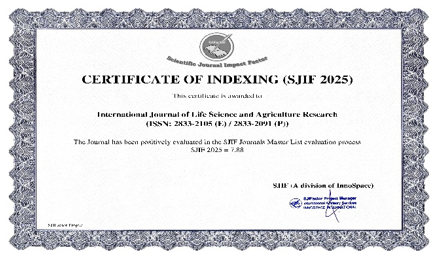Soil Fertility Status of the Two Eruptions of Mount Tangkuban Parahu and Mount Tampomas in Tanjungsari District Sumedang Regency
DOI:
https://doi.org/10.55677/ijlsar/V03I8Y2024-01Keywords:
Soil Physical Characteristics, Soil Chemical Characteristics, Land UnitAbstract
Soil fertility is one of the important factors to optimize plant growth and productivity. This study aims to analyze the status of soil fertility through soil physical analysis (texture) soil chemistry (pH H2O and KCl, C-organic, cation exchange capacity, base saturation, P2O5, and K2O) in several land units of Tanjungsari District, Sumedang Regency. The method used to determine sample points is purposive sampling method by considering several land units, namely soil type map, soil parent material map, topography map (slope), land use map, and rainfall data. Soil fertility status is determined by the matching table method between the results of soil chemical analysis with soil fertility status index that refers to the Soil Research Center (PPT) 1995. The results of the matching table data analysis showed that the research area almost entirely included low fertility status criteria except for the pine forest land unit on a moderately steep slope including medium fertility status criteria. The factors of base saturation, k-potential (K2O), and C-organic are the limiting factors of soil fertility status in the Tanjungsari District of Sumedang Regency, including the low to medium category.
References
Al Mu'min, M. I., Joy, B., & Yuniarti, A. (2016). Dinamika kalium tanah dan hasil padi sawah (Oryza sativa L.) akibat pemberian npk majemuk dan penggenangan pada fluvaquentic epiaquepts. soilrens, 14(1).
Andira, U. Kila, Y. M., & Kapoe, S. K.K.L. (2022). Analisis Sifat Kimia Tanah Pada Lahan Pertanian Di Kelurahan Kawangu Kecamatan Pandawai Kabupaten Sumba Timur. Jurnal Agro Indragiri, 7(2), 22-26.
Benu, F. L., & Mudita, I. W. (2013). Revisitasi lahan kering: diskusi ringan seputar lahan kering dan pertanian lahan kering. JP II Publishing House.
Hardjowigeno, S. 2010. Ilmu Tanah. Akademika Pressindo, Jakarta.
Idjudin, A. A., Erfandi, M. D., & Sutono, S. (2012). Teknologi peningkatan produktivitas lahan endapan volkanik pasca erupsi gunung Merapi.
Kartina, A. M., Nuniek, H., & Fatmawaty, A. A. (2016). Perbandingan sifat kimia dan kesuburan fisik tanah pada kondisi tempat tumbuh alami dan budidaya talas beneng (Xanthosoma undipes K. Koch) Di Kawasan Gunung Karang Kampung Juhut Kabupaten Pandeglang Provinsi Banten. Jurnal Agroekoteknologi, 8(1).
Maranon, M., M. Soriano, G. Delgado and R. Delgado. 2002. Soil Euquality in Mediteranian Mountain Environrnents: Effect of Land Use Change. Soil Science Society American Joumal. 66:94t-958.
Maro'ah, S., Sunarminto, B. H., & Utami, S. N. H. (2021). Status Kesuburan Tanah sebagai Dasar Strategi Pengelolaan Lahan Sawah di Kabupaten Bantul, Indonesia. AgriHealth: Journal of Agri-food, Nutrition and Public Health, 2(2), 78-87.
Mukhlis. 2007. Analisis Tanah dan Tanaman. Universitas Sumatra Utara. Medan.
Septianugraha, R., & Suriadikusumah, A. (2014). Pengaruh penggunaan lahan dan kemiringan lereng terhadap C-organik dan permeabilitas tanah di Sub DAS Cisangkuy Kecamatan Pangalengan, Kabupaten Bandung. Agrin, 18(2).
Teul, M. U., Killa, Y. M., & Ndapamuri, M. H. (2024). Pengaruh Beberapa Tipe Penggunaan Lahan Terhadap Sifat Kimia Tanah di Kecamatan Wula WAijelu Kabupaten Sumba Tmur. Jurnal Agro Indragiri, 9(1), 41-46.












